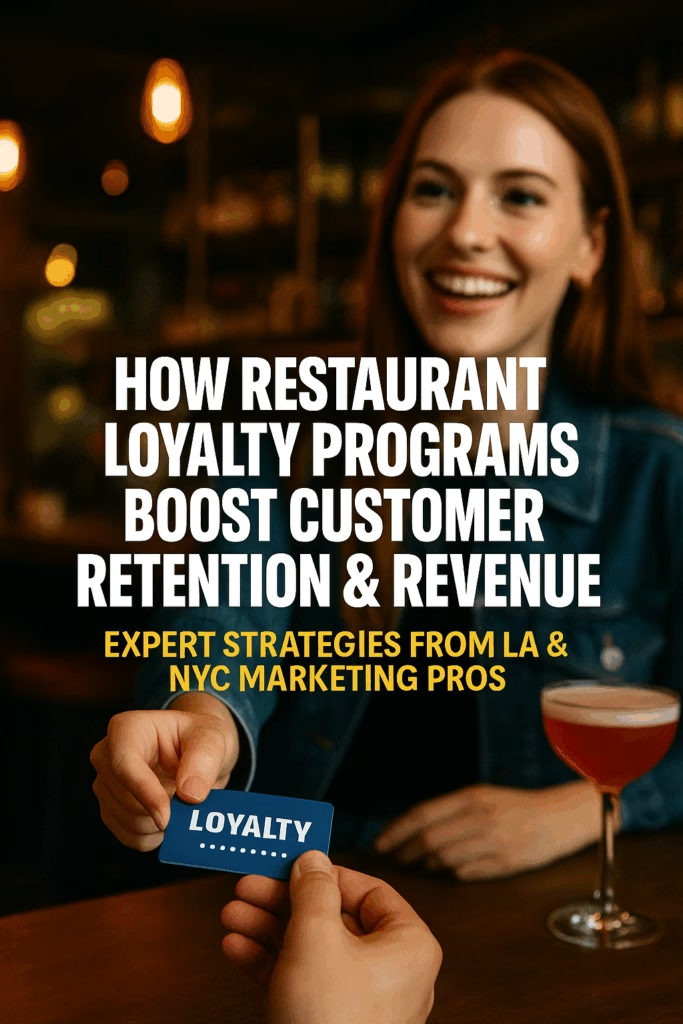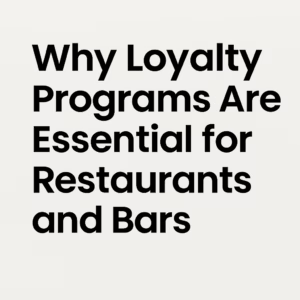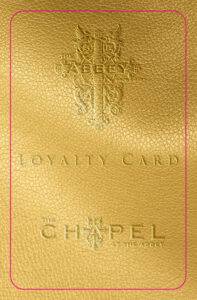Restaurant Digital Marketing and Social media Loyalty Programs That Actually Work!
Restaurant loyalty programs are transforming digital marketing and social media in the hospitality industry by turning casual visitors into devoted customers. The hospitality industry especially in Los Angeles and New York City thrives on relationships, and these powerful tools serve as the secret weapon for success. Whether you’re running a cozy neighborhood bistro in Tribeca, managing a high-energy nightclub in West Hollywood, or operating a beachside bar in Laguna Beach, your success depends on one critical factor: getting customers to come back. Yet many restaurant and bar owners still rely on outdated marketing tactics, hoping that great food and atmosphere alone will build a loyal customer base.
The reality is more complex. In today’s competitive landscape, restaurant loyalty programs that work aren’t just nice-to-have perks – they’re essential business tools that can mean the difference between thriving and merely surviving. When implemented correctly, these restaurant loyalty programs transform casual visitors into devoted advocates who not only return regularly but actively promote your brand to their networks.
This comprehensive guide explores why restaurant loyalty programs have become indispensable for restaurants, bars, and nightlife brands, backed by real-world case studies and actionable insights that you can implement immediately to drive repeat business and sustainable growth.
What Makes Restaurant Loyalty Programs Essential for Hospitality Brands
The numbers tell a compelling story. According to Harvard Business Review research, increasing customer retention rates by just 5% can increase profits by 25% to 95%. For hospitality businesses operating on thin profit margins, this is transformative.
Why Customer Acquisition Costs Keep Rising
Bar loyalty card programs and restaurant reward systems work. They address a fundamental challenge in the hospitality industry. Customer acquisition costs continue to rise while customer attention spans shrink. Traditional advertising methods are becoming less effective. Consumers develop ad fatigue and seek more authentic, personalized experiences.
Loyalty programs flip this dynamic entirely. Instead of constantly chasing new customers through expensive acquisition channels, successful hospitality brands focus differently. They maximize the lifetime value of existing customers. A well-designed program doesn’t just encourage repeat visits. It creates emotional connections that transcend simple transactional relationships.
The Economics of Customer Retention
Consider the economics. Acquiring a new customer typically costs five to seven times more than retaining an existing one. For a restaurant spending $50 to acquire a new customer through digital advertising, that same investment works better elsewhere. Loyalty program rewards for existing customers often yield significantly higher returns. This happens through increased visit frequency and higher average order values.
The most effective nightlife marketing strategies recognize that today’s consumers, particularly millennials and Gen Z, value experiences and recognition over purely transactional relationships. They want to feel like insiders, to be recognized by staff, and to enjoy exclusive perks that acknowledge their loyalty. Smart hospitality brands leverage this desire through sophisticated restaurant loyalty programs that go far beyond simple punch cards.
The Psychology Behind Restaurant Loyalty Programs in Bars and Restaurants
Understanding customer psychology is crucial for developing restaurant loyalty programs that actually work. The hospitality industry is inherently emotional. People don’t just come to restaurants and bars for sustenance or drinks. They come for connection, celebration, relaxation, and social experiences. Successful restaurant loyalty programs tap into these deeper motivations.
The Power of Reciprocity in Customer Behavior
The concept of reciprocity plays a significant role in customer behavior. When a restaurant or bar provides unexpected value, customers respond positively. This might include a complimentary appetizer, priority seating, or exclusive event invitations. Customers feel compelled to reciprocate through continued patronage and positive word-of-mouth marketing.
Status and recognition are equally powerful motivators. The best loyalty platforms for restaurants understand that customers want to feel special and acknowledged. This might manifest as a VIP section reservation. It could mean personalized service where staff know their preferred drinks. Early access to special events also works well. These touches make customers feel valued beyond their monetary contribution.
Loss Aversion and Habit Formation
The psychology of loss aversion also influences loyalty program effectiveness. Customers become emotionally invested in maintaining their status level or accumulated points. This makes them more likely to choose your establishment over competitors to preserve their progress. This psychological principle explains why tiered loyalty programs often outperform simple point-accumulation systems.
Habit formation represents another crucial psychological component. Successful loyalty programs create positive feedback loops. These reinforce regular visitation patterns. When customers receive rewards for behavior you want to encourage, they respond well. This includes visiting during slower periods or trying new menu items. They’re more likely to repeat these actions even without immediate rewards.
Social media marketing for bars becomes significantly more effective when integrated with loyalty programs. Customers who feel genuinely appreciated are natural brand ambassadors, sharing their positive experiences across social platforms and bringing friends to join them. This organic promotion is far more valuable than paid advertising because it comes with built-in trust and authenticity.
Digital vs Traditional Restaurant Loyalty Programs: Why Modern Wins
The evolution from traditional punch cards to sophisticated digital platforms represents more than technological advancement – it’s a fundamental shift in how hospitality businesses can understand and serve their customers. While old-school punch cards might still work for coffee shops, modern restaurants, bars, and nightlife venues require more sophisticated restaurant loyalty programs.
Digital restaurant loyalty programs offer unprecedented data insights that traditional methods simply cannot match. When a customer uses a digital loyalty app or card, you immediately gain access to valuable information: visit frequency, average spend, preferred times, favorite menu items, and spending patterns. This data enables personalized marketing that would be impossible with paper-based systems.
Digital marketing for hospitality brands becomes exponentially more effective when powered by loyalty program data. Instead of sending generic promotions to your entire customer base, you can create targeted campaigns. Such personalized approaches speak directly to individual preferences and behaviors. A customer who visits primarily on weekends might receive different offers. Someone who frequents weekday happy hours gets different promotions.
The Convenience Factor
The convenience factor cannot be overstated. Today’s consumers expect seamless, mobile-integrated experiences. Digital loyalty programs allow customers to check their points balance easily. They can redeem rewards and receive personalized offers without carrying additional cards. No need to remember to bring punch cards. This friction reduction significantly increases program engagement and usage rates.
Real-Time Communication Capabilities
Real-time communication capabilities represent another major advantage of digital platforms. Traditional loyalty programs offer limited opportunities for ongoing customer engagement between visits. Digital systems enable push notifications for special events. Personalized birthday offers, exclusive previews of new menu items, and time-sensitive promotions drive immediate action.
Integration possibilities with existing point-of-sale systems work well. Social media marketing strategy and customer relationship management tools make digital loyalty programs powerful business intelligence tools. You can track program ROI with precision. You can identify your most valuable customers. You can adjust strategies based on real performance data rather than guesswork.
The scalability of digital programs also supports business growth. As your restaurant, bar, or nightlife venue expands whether through additional locations or increased customer volume digital loyalty platforms can accommodate growth without requiring proportional increases in administrative overhead.
Case Study: How Restaurant Loyalty Programs Transform Casual Visitors into Weekly Regulars
A Restaurant Loyalty Program Success Story
We created a loyalty program for The Abbey in West Hollywood, one of the most iconic nightlife brands in the country. It helped turn casual visitors into weekly regulars. Customers returned not just for the atmosphere, but because they felt welcomed, appreciated, and rewarded. A simple gesture like a free drink or exclusive invite makes a guest feel like part of something. Loyalty isn’t about discounts. It’s about recognition, comfort, and community. Without loyal repeat customers, even the best restaurants and bars struggle. With them, you’ve got momentum, referrals, and long-term growth.
The Challenge Before Implementation
The Abbey’s transformation illustrates several key principles that make loyalty programs effective in the nightlife industry. Before implementing their digital rewards system, The Abbey already had strong brand recognition and an excellent reputation. However, they faced challenges common to many nightlife venues. These included high customer acquisition costs, inconsistent weekend-to-weekday traffic, and difficulty building lasting relationships with customers in a party-focused environment.
Strategic Program Design
The West Hollywood nightlife digital strategy we developed focused on creating multiple touchpoints for customer engagement. This went beyond just the Saturday night party scene. Our loyalty program rewarded customers for mid-week visits, early arrival times, and bringing friends. Such behaviors directly supported business objectives while providing genuine value to customers.
Rather than simply offering percentage discounts, The Abbey’s program emphasized experiential rewards. VIP line access, complimentary specialty cocktails, exclusive event invitations, and personalized service recognition were key features. Such rewards aligned perfectly with what nightlife customers actually value: status, convenience, and unique experiences.
Measurable Results and Impact
The results spoke volumes about effective West Hollywood nightlife restaurant social media marketing strategy integration. Loyalty program members became organic content creators. They shared their VIP experiences on social media and tagged friends who should join them. This user-generated content proved far more authentic and effective than traditional advertising approaches.
Within six months of launch, The Abbey saw measurable improvements across key performance indicators. Average customer lifetime value increased by 35%. Mid-week attendance grew by 22%. Social media engagement rates improved significantly. Perhaps more importantly, staff reported stronger relationships with regular customers. This created a more positive atmosphere that benefited everyone.
Key Features That Make Restaurant Loyalty Programs Work
Successful restaurant loyalty programs share certain characteristics that distinguish them from ineffective ones. Understanding these features is crucial for restaurant marketing agency in Los Angeles professionals and hospitality business owners. They want to implement restaurant loyalty programs that drive real results rather than just adding administrative complexity.
Simplicity and Clarity
The best loyalty programs are immediately understandable. Customers should be able to explain how your program works to a friend in under 30 seconds. Overly complex point systems create problems. Confusing redemption requirements or unclear tier structures create friction that reduces participation. Successful programs use straightforward mechanics: spend X, get Y, or visit Z times for a specific reward.
Meaningful Rewards That Match Customer Values
Effective rewards align with what your customers actually value. For upscale restaurants, this might mean priority reservations during peak times. It could include exclusive access to special menus. For casual bars, it could be happy hour pricing extended to loyalty members or complimentary appetizers. The key is understanding your customer base. Craft rewards that feel valuable relative to their typical spending patterns.
Multiple Earning Opportunities
Beyond transaction-based points, successful programs reward various customer behaviors that benefit the business. Social media sharing, referring friends, participating in events, or visiting during traditionally slower periods all earn points. Diversified earning opportunities keep customers engaged between visits and support broader business objectives.
Personalization and Technology Integration
Modern customers expect personalized experiences. Effective loyalty platforms enable customized communications, offers, and rewards based on individual customer data. This might mean birthday specials, favorite-drink notifications, or targeted promotions for menu items similar to previous orders.
The technology powering your loyalty program should integrate smoothly with existing systems. Point-of-sale integration ensures automatic point crediting without requiring staff to remember separate processes. Mobile app integration allows customers to check balances, receive notifications, and redeem rewards without additional friction.
Staff Training and Buy-in
Even the most sophisticated technology fails without proper staff implementation. Successful loyalty programs include comprehensive staff training that covers not just technical processes but also how to use the program to enhance customer service. When staff understand the program’s value and feel empowered to use it creatively, customer experiences improve dramatically.
Regular Communication
Effective programs maintain ongoing customer engagement through strategic communication. This includes welcome series for new members, regular program updates, exclusive offers, and event invitations. The communication should provide value beyond pure promotion, positioning your loyalty program as a source of insider information and special opportunities.
How Restaurant Loyalty Programs Drive Social Media and Word-of-Mouth Marketing
The intersection of restaurant loyalty programs and social media creates powerful amplification effects. These extend far beyond direct program participation. When customers feel genuinely appreciated and receive exceptional experiences through loyalty rewards, they naturally want to share these positive moments with their networks.
Authentic Content Creation
Tribeca bar social media marketing strategies become significantly more effective when integrated with loyalty programs. They provide continuous content opportunities. Loyalty members attending exclusive events, enjoying special perks, or receiving personalized service create authentic content. This showcases your brand in real-world situations rather than staged promotional scenarios.
User-generated content from loyalty program members carries inherent credibility that paid advertising cannot match. When someone posts about their VIP experience or exclusive menu preview, their followers see authentic enthusiasm rather than corporate messaging. This organic promotion typically generates higher engagement rates and drives more qualified traffic than traditional advertising approaches.
Viral Network Effects
When loyalty rewards encourage customers to bring friends, each program member becomes a distribution channel. Referral bonuses, group discounts, or exclusive party invitations make this happen. Each program member helps expand your customer base. Such network effects can accelerate growth exponentially while maintaining lower acquisition costs.
Calabasas restaurant branding and Newport Beach restaurant SEO strategies benefit significantly from the local authority that loyalty programs help establish. Regular customers become community ambassadors. They promote your establishment through word-of-mouth recommendations, online reviews, and social media activity. This local advocacy improves search engine rankings while building authentic community connections.
The data insights from loyalty programs also inform more effective social media strategies. Understanding which rewards generate the most social sharing, which customer segments are most active on specific platforms, and which types of experiences drive viral content helps optimize your broader digital marketing approach.
Laguna Beach bar advertising becomes more targeted and effective when loyalty program data reveals customer preferences, behaviors, and social media usage patterns. Instead of generic campaigns, you can create highly targeted advertisements that speak directly to demonstrated interests and behaviors.
Measuring Restaurant Loyalty Program Success: KPIs That Matter for Hospitality Brands
Effective restaurant loyalty programs management requires systematic measurement of key performance indicators. KPIs must align with broader business objectives. The most successful hospitality marketing in NYC strategies include robust analytics frameworks. Such frameworks track both direct program performance and broader business impact.
Core Financial Metrics
Customer Lifetime Value (CLV)
Perhaps the most critical metric for hospitality businesses, CLV measures the total revenue a customer generates over their entire relationship with your establishment. Effective loyalty programs should demonstrably increase CLV. This happens through higher visit frequency, increased average order values, and extended customer relationships.
Repeat Visit Rate
This metric tracks what percentage of customers return for additional visits within specific timeframes. Successful loyalty programs typically see significant improvements in 30-day, 60-day, and 90-day repeat visit rates compared to non-program customers.
Engagement and Growth Metrics
Average Order Value (AOV)
Loyalty program members often spend more per visit than regular customers. This happens either because rewards encourage larger orders or because the program attracts higher-value customers. Tracking AOV differences between program members and regular customers helps quantify program effectiveness.
Program Engagement Rates
Beyond basic enrollment, successful programs maintain high engagement levels. These are measured through point redemption rates, email open rates, mobile app usage, and social media interaction. Low engagement rates often indicate program design issues that require attention.
Marketing and Referral Performance
Referral Generation
Word-of-mouth marketing represents one of the most valuable outcomes from effective loyalty programs. Tracking referral rates, friend invitation acceptance, and new customer acquisition through existing members provides insight into program viral potential.
Revenue Attribution
Understanding what percentage of total revenue comes from loyalty program members helps justify program investment. It also guides resource allocation decisions. Many successful hospitality businesses see 40-60% of total revenue generated by loyalty program participants.
Cost Per Acquisition vs Retention
Comparing the cost of acquiring new customers through traditional marketing channels versus retaining existing customers through loyalty programs typically reveals significant advantages for retention-focused strategies.
Social Media Amplification
Measuring social media mentions, user-generated content, and engagement rates from loyalty program members helps quantify the broader marketing value beyond direct revenue impact.
Common Restaurant Loyalty Program Mistakes to Avoid When Launching Your Program
Learning from common pitfalls can save significant time, money, and customer goodwill. Such lessons apply when implementing loyalty programs for restaurants, bars, and nightlife venues. These mistakes are particularly relevant for Orange County, California digital marketing firm clients and hospitality businesses across competitive markets.
Customer Loyalty Program Design and Implementation Mistakes
Over-Complicating the Structure
The most frequent mistake involves creating unnecessarily complex point systems, tier structures, or redemption requirements. Customers should immediately understand how to earn and use rewards. They shouldn’t need detailed explanations or reference materials. Complexity creates friction that reduces participation and diminishes program effectiveness.
Insufficient Staff Training
Launching a loyalty program without comprehensive staff training often leads to problems. These include inconsistent implementation, customer confusion, and missed opportunities for program promotion. Every team member should understand program mechanics, benefits, and how to enroll new members naturally during customer interactions.
Reward and Communication Issues
Generic Rewards That Don’t Match Customer Values
Offering rewards that don’t align with your customer base’s preferences wastes resources and reduces program appeal. Upscale restaurant customers might value exclusive experiences over percentage discounts. Casual bar patrons might prefer extended happy hour access over premium wine tastings.
Inconsistent Communication
Sporadic or overwhelming communication diminishes program value. Successful programs maintain regular, valuable contact with members. This happens through targeted offers, event invitations, and exclusive information. Finding the right communication frequency requires testing and adjustment based on customer response.
Technical and Strategic Errors
Failing to Integrate with Existing Systems
Loyalty programs that require separate processes for staff create problems. Programs that don’t integrate with point-of-sale systems create operational complexity that reduces adoption. Seamless integration ensures consistent implementation and reduces the likelihood of errors or forgotten point credits.
Launching Without Clear Objectives
Programs implemented without specific, measurable goals often lack focus and fail to deliver meaningful results. Whether your objective is increasing visit frequency, boosting off-peak traffic, or improving average order values, clear goals guide program design and measurement strategies.
Data and Technology Oversights
Ignoring Data and Analytics
Many hospitality businesses implement loyalty programs but fail to analyze performance data systematically. Without regular review of engagement rates, redemption patterns, and revenue impact, it’s impossible to optimize program effectiveness. It’s also impossible to justify continued investment.
Inadequate Technology Infrastructure
Choosing loyalty program platforms without considering scalability creates problems. Not considering integration capabilities or customer experience often leads to future problems as programs grow. Investing in robust technology from the beginning prevents costly migrations. It also ensures smooth customer experiences.
The Future of Restaurant Loyalty Programs in Hospitality
The loyalty program landscape continues evolving rapidly. This is driven by technological advancement, changing consumer expectations, and new competitive pressures. Forward-thinking hospitality businesses that understand emerging trends position themselves for sustained competitive advantages.
AI and Personalization Advances
Artificial Intelligence and Personalization
AI-powered loyalty platforms increasingly enable hyper-personalized experiences. These adapt in real-time to customer behavior patterns. These systems can predict optimal offer timing, recommend menu items based on preferences and dietary restrictions. They can automatically adjust reward structures to maximize individual customer engagement.
Integration with Smart City Infrastructure
As cities implement smart technology for transportation, events, and tourism, loyalty programs that integrate with these systems create seamless urban experiences. Customers might receive parking discounts, public transportation credits, or coordinated recommendations across multiple participating businesses.
Emerging Technology Trends
Sustainability and Social Responsibility
Younger consumers increasingly value brands that demonstrate environmental and social consciousness. Future loyalty programs will likely incorporate sustainability rewards, charitable giving options, and community involvement opportunities. These align with member values beyond pure consumption.
Voice Technology and IoT Integration
Smart speakers, connected devices, and voice-activated systems create new opportunities for loyalty program interaction. Customers might check point balances, make reservations, or receive personalized recommendations through voice interfaces integrated with their smart home systems.
Next-Generation Technologies
Blockchain and Cryptocurrency
Distributed ledger technology could enable interoperable loyalty programs. Points earned at one establishment could be used at partner locations. Cryptocurrency integration might allow global travelers to maintain consistent loyalty benefits across international restaurant and bar networks.
Augmented Reality Experiences
AR technology could transform how customers interact with loyalty programs. This enables virtual menu previews, gamified point collection, or enhanced social sharing experiences that bridge physical and digital environments.
Operational Integration Benefits
Predictive Analytics for Inventory and Staffing
Advanced analytics from loyalty program data will increasingly inform operational decisions beyond marketing. Understanding customer patterns helps optimize inventory management, staff scheduling, and menu planning. This improves efficiency and customer satisfaction.
The hospitality businesses that thrive in coming years will be those that view loyalty programs differently. They won’t see them as simple reward systems. Instead, they’ll use them as comprehensive customer relationship platforms. These enable deeper connections, operational insights, and sustainable competitive advantages.
Building Long-Term Success Through Restaurant Loyalty Programs and Customer Community
The most successful loyalty programs transcend transactional relationships to create genuine communities around hospitality brands. This evolution from customer rewards to community building represents the next frontier in hospitality marketing and customer retention.
Building Long-Term Success Through Customer Community
The most successful loyalty programs transcend transactional relationships to create genuine communities around hospitality brands. This evolution from customer rewards to community building represents the next frontier in hospitality marketing and customer retention.
Creating Customer-to-Customer Connections
Effective restaurant loyalty programs that work foster connections not just between customers and brands but among customers themselves. This might involve member-exclusive events, private social media groups, or special dining experiences that bring loyal customers together. When customers develop relationships with each other through your establishment, their loyalty becomes exponentially stronger. Leaving means losing social connections, not just rewards.
Feedback Loops and Business Intelligence
Community-building also creates powerful feedback mechanisms that inform business improvement. Loyal customers who feel heard and valued provide honest insights about menu changes, service improvements, and new concept ideas. This feedback loop enables continuous refinement. It keeps your establishment ahead of competitors while making customers feel like valued partners in your success.
The social proof generated by strong customer communities amplifies marketing effectiveness across all channels. When potential customers see active, engaged communities surrounding your brand, they perceive higher value and social desirability. This perception makes them more likely to visit initially. It also makes them more receptive to joining your restaurant loyalty programs.
Technology Platforms for Restaurant Loyalty Program Community Building
Best loyalty platforms for restaurants increasingly include community features that facilitate customer connections and user-generated content creation. These platforms recognize that today’s consumers, particularly younger demographics, value experiences and relationships over purely transactional interactions.
As the hospitality industry becomes increasingly competitive, the businesses that invest in building genuine customer communities through sophisticated restaurant loyalty programs will enjoy sustainable advantages. These extend far beyond simple repeat visits. They’ll create customer advocates who actively promote their brands, provide valuable business insights, and contribute to positive atmospheres that benefit all customers.
The future belongs to hospitality businesses that understand loyalty isn’t just about rewards. It’s about recognition, relationships, and creating spaces where people feel they truly belong.
Socially Intrigued is an award-winning digital marketing and social media agency with offices in Los Angeles and New York City. We specialize in helping restaurants, bars, and hospitality brands build loyal customer bases, grow online, and dominate their market. Want to grow your loyalty program and digital presence?
Visit Socially Intrigued or call (888) 306-8688.
Ready to transform your hospitality business with a loyalty program that actually works? Our team has helped countless restaurants, bars, and nightlife venues across Los Angeles, New York, and beyond create customer loyalty programs that drive real results. From concept development to implementation and ongoing optimization, we provide comprehensive solutions that turn occasional visitors into devoted advocates.
Contact us today to discover how the right loyalty program strategy can revolutionize your customer relationships and accelerate your business growth. Check out our clients to see the success stories we’ve created for hospitality brands just like yours.



